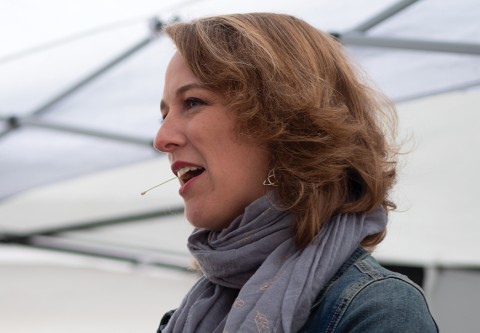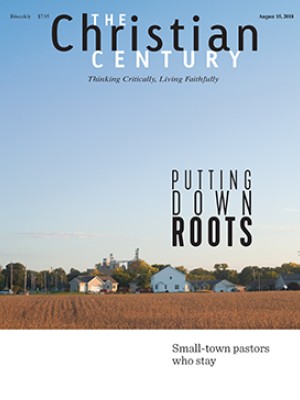They sold First UMC and put up a tent in the parking lot
"It feels vulnerable to be the weird lady outside preaching sermons."

After Mandy Sloan McDow became pastor of the First United Methodist Church of Los Angeles, the oldest Protestant church in the city, the congregation started holding its worship services in a parking lot. The church had sold its historic building in the early 1980s and used the proceeds to support affordable housing units, create an endowed chair of urban ministry at Claremont School of Theology, and launch the Urban Foundation, which focuses on helping first-generation Hispanic students gain access to college. Without a building of its own, the congregation had met for worship in a senior housing facility it helped build. The church’s remaining piece of property is a parking lot, which generates regular income that is used to support ministry.
How did your congregation start worshiping in the parking lot?
My first Sunday was July 1, 2017. Prior to that, First Church didn’t have an appointed pastor. The congregation had been meeting informally in a multipurpose room of an affordable housing facility. On that day, I asked the congregation to pick up everything—chairs, altar table, candles, cross, Bible, and baptismal font—and march outside to the tent I had set up in our parking lot, the church’s only remaining property. I told them that the history of the church and its ministries, especially its commitment to providing housing, conveyed a powerful message, but no one was going to hear it if we stayed inside an obscure building.
Read our latest issue or browse back issues.
“We are not going to hide our light under a bushel,” I said; “we’re going to take our light into the world.” I was pretty nervous about what they would do and if they would participate. I didn’t warn them ahead of time. They did it with joy.
What has it been like to meet outside?
Terrifying. It feels especially vulnerable to be the weird lady standing outside preaching sermons. It is remarkable, though, to see who comes.
Who comes?
About 80 percent of the people who come are straight Filipino ladies, and 20 percent are members of the queer community. We have people come by who are just curious. We see a lot of homeless people. They come in and out of services. Frankly, they’re some of our most consistent attendees. They know where to find us now, and we show up in the same place they do. We do blessings, and we make sure we have healthy food to share with them. There’s coffee; there’s water. Take this communion, take this time. Please take all that we have.
On a recent Sunday a guy wandered over and plopped down in the front row during the prayers of the people. He shouted out a few semi-intelligible things. Right after the prayers of the people, we do the passing of the peace. I watched as the congregation approached him and shook hands with him. They treated him as if he was already one of them. They asked his name, invited him to sit down, and he stayed for the whole worship service. It was really moving to me.
Why did you think this move would work?
The church has a history of welcoming minorities, immigrants, and refugees and of doing subversive social justice actions because they believed it was right. It is an incredibly resilient church that has done all that it can to sink its resources into the community. This is not a church that has to be urged to do the right thing.
What’s the point of meeting in the parking lot?
Los Angeles has a rampant housing crisis: there are 58,000 homeless people living in our city. So this is one of the ways that our land gets to be an expression of our theology. We will remain unhoused as a church in solidarity with our houseless neighbors, until we can build something that will provide housing for them and for the church. We’ve listened to the prayers of the people for stability and access to housing. We believe that the barrier to worship with us is much lower when we meet outside.
What comes next?
We are considering transforming the parking lot into a site for permanent supportive housing, workforce housing, and market-rate housing as well as a beautiful space for the church to hold worship. For me, the highest ideal would be to create a theologically centered co-housing community that people could afford, one where residents would be expected to give back to the community, and take care of one another, just as it’s demonstrated in Acts 4.
For example, someone could give ten hours a month to babysit a neighbor’s kids, or so that neighbors could have a free date night. Or someone could agree to make a pot of soup for a sick neighbor. Everybody would have their own private space to accommodate their families, but for the most part people would agree to do things in common. They might have a meal together once a week. Our church would hold worship services in the building. The church would also provide opportunities for people looking for ways to help the neighborhood.
If we invert the model of church, so that we’re building what people are asking for (affordable housing), then the church no longer has to panic about people coming inside its walls. We will have listened to the call of the gospel to sell what we have (in our case, the parking lot revenue), and share it with those in need, so that no one has to worry or go without. I am hopeful that we can build a faith community that reimagines what it means to be church, living out its faith in the world.
A version of this article appears in the print edition under the title “Church in a parking lot.”




